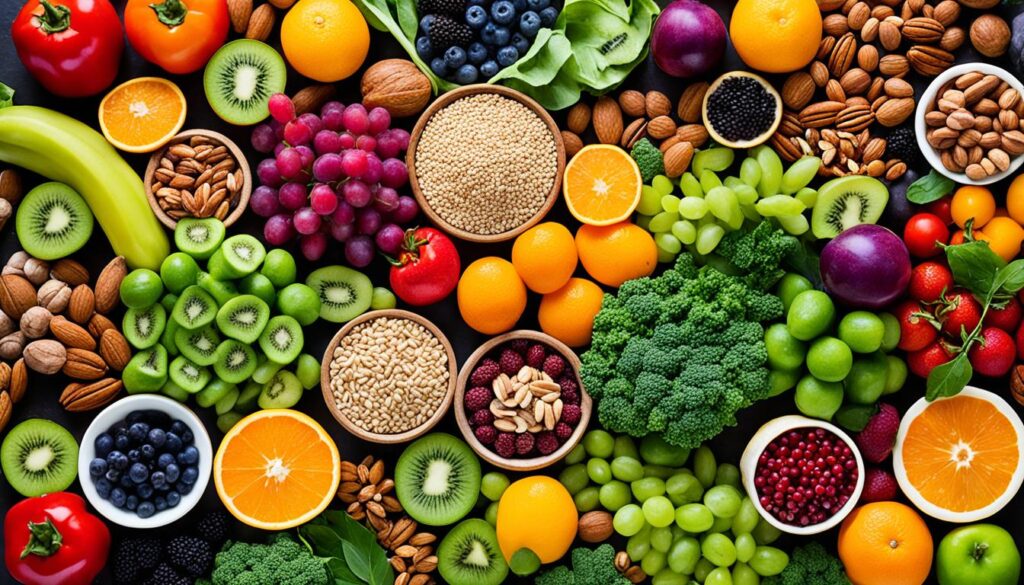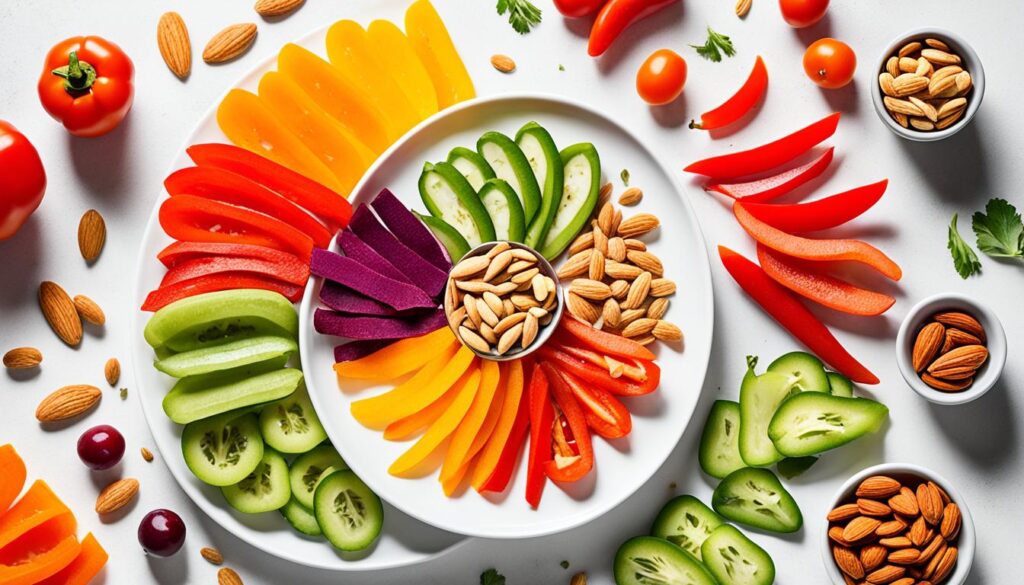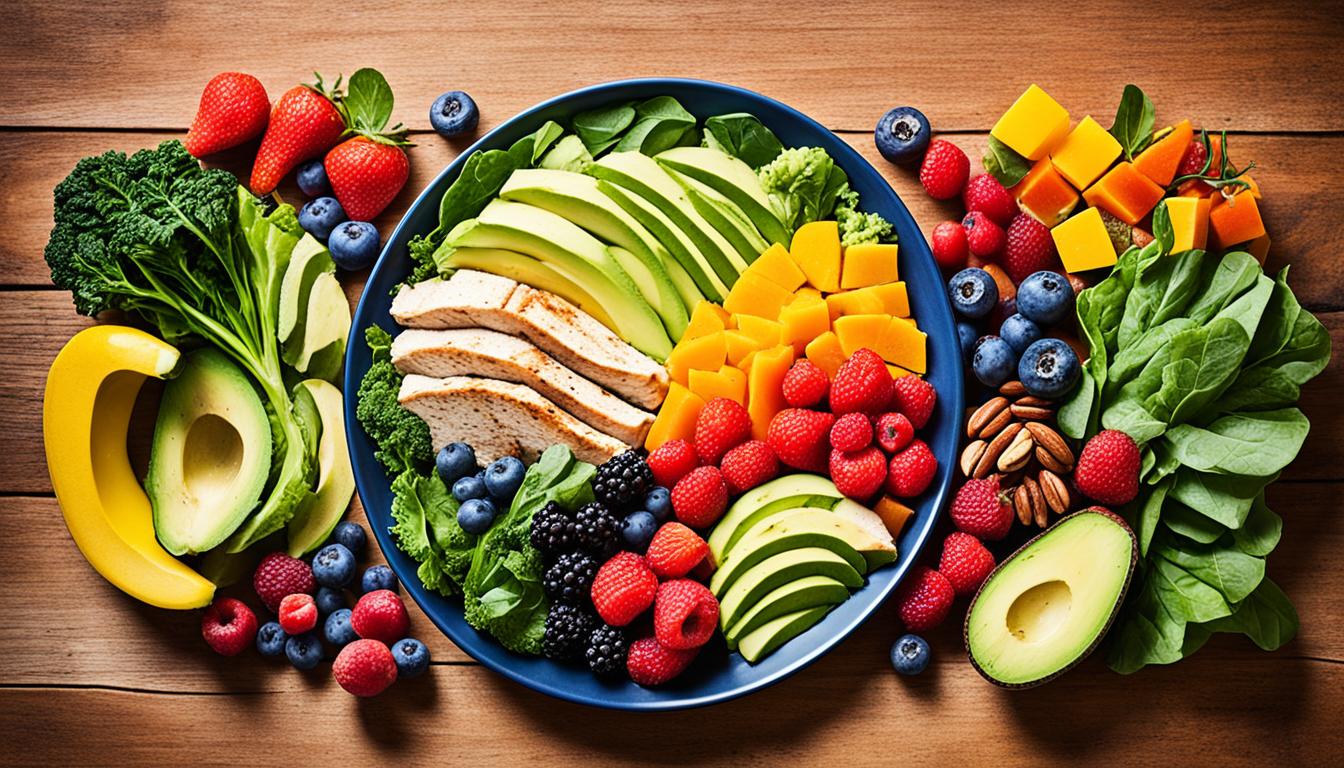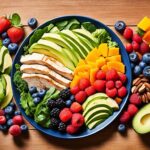Feeling low on energy or like you’re in a health rut? The food you eat might hold the key to boosting your vitality. Nutrient-dense meals are essential for enhancing your health and energy levels. But how do you know which foods to pick, and how to fit them into your daily routine?
By adding nutrient-dense meals to your menu, you can fix this. These meals are packed with vitamins, minerals, and other essential nutrients, but don’t have as much unhealthy fat, sugar, or salt. Studies even show that many diets lack in key nutrients,1, making it vital to choose foods with the most nutrients for each calorie.
Making nutrient density a priority in what you eat will crank up your energy levels. It supports feeling well and might help with keeping your weight in check. This approach turns every bite into a step towards better health and energy.
Key Takeaways
- Nutrient-dense foods are rich in vitamins, minerals, and other essential nutrients, while being low in saturated fat, added sugars, and sodium.
- The standard American diet is often energy-rich but nutrient-poor, highlighting the importance of choosing foods that provide the most nutrients per calorie.
- Incorporating nutrient-dense meals can help boost energy levels, support overall well-being, and potentially aid in weight management.
- Focusing on an overall balanced diet, rather than just specific nutrients or foods, is crucial for achieving optimal nutrient density.
- Simple swaps, such as using whole-grain products and low-fat dairy alternatives, can enhance the nutrient density of meals.
Understanding Nutrient Density
Nutrient density shows how healthy a food is compared to the calories it has.2 Foods packed with vitamins and minerals, like veggies and fruits, are nutrient-dense.2 They give us a lot of good stuff without many bad things like sugar or saturated fat.2 On the other hand, energy-dense foods are full of calories but lacking in good nutrients. We call these “empty calories.”2
What is Nutrient Density?
Food is deemed more nutrient dense if it has lots of good nutrients for each calorie.2 Experts use formulas to check if foods are truly nutrient dense by comparing them to what a healthy diet should include.2 Nutrient-dense foods are things like veggies, fruits, whole grains, fish, and even nuts and seeds.2
Nutrient-Dense Foods vs Energy-Dense Foods
Profiling foods this way helps us see what’s good for us and what might be too much, like fats or sugars.2 Some foods can be both full of nutrients and high in calories. This shows why we need to balance our meals with the right kinds of foods.2
Assessing Nutrient Density Beyond Nutrition Labels
Checking for nutrient density means looking into how processed a food is. Generally, less processed foods are richer in nutrients.2 Changing how we cook and the meals we pick can boost the nutrients in our diet.2
Even though most people in a survey have heard about nutrient density, many are not sure how to pick the right foods.3 Knowing the difference between nutrient-packed and calorie-filled foods can steer us toward better eating habits.2
Benefits of Eating Nutrient-Dense Foods
Adding nutrient-dense foods to your meals has many pluses. These foods are full of vitamins, minerals, and fiber. They ease inflammation, boost your immune system, and keep your body working well.4 They’re great for managing weight, too. Because they fill you up, you’re less likely to eat too much.4 They’re also a good source of energy. This means they can keep you going all day.4 Plus, they’re a key part of eating a healthy, varied diet.
Support Overall Health and Well-being
Nutrient-dense foods like veggies, fruits, and fish are rich in antioxidants. They help fight off sickness and keep your body in good shape.4 Eating them regularly can help your brain, bones, and muscles stay strong.4
Promote Weight Management
Choosing nutrient-dense foods is smart for staying at a healthy weight. They’re packed with nutrients but not a lot of calories.4 This means they keep you satisfied and help you avoid overeating.4 With lots of fiber and protein, they also stabilize your blood sugar and keep you full. This supports weight control.
Enhance Energy Levels
Nutrient-dense foods are a great energy source. They’re full of vitamins, minerals, and carbs that your body uses for fuel.4 Eating them gives you better mental focus, more stamina, and higher energy levels.4 Snacking on nutrient-rich foods can make you feel powered up and ready for anything.
Building a Nutrient-Dense Diet
Start by choosing whole, minimally processed foods for your diet. Fruits, vegetables, whole grains, lean proteins, and healthy fats are key. These foods keep their natural nutrients and usually don’t have added unhealthy stuff.1
Prioritize Plant-Based Sources
Foods like leafy greens, berries, nuts, and legumes add a lot of nutrition to your meals. They’re packed with fiber, vitamins, minerals, and healthy plant compounds.5
Balance Macronutrients
It’s also important to eat a mix of carbohydrates, protein, and fats. This balance helps your body absorb and use nutrients well. That leads to improved health and energy.5
| Nutrient-Dense Foods | Benefits |
|---|---|
| Fruits, Vegetables, Whole Grains | High in vitamins, minerals, and fiber |
| Lean Proteins (Chicken, Fish, Beans) | Provide essential amino acids and support muscle health |
| Healthy Fats (Nuts, Seeds, Avocado) | Deliver beneficial fatty acids and aid in nutrient absorption |
Nutrient-dense meals

Crafting nutrient-dense meals means using whole foods that are not heavily processed. They give us lots of vitamins, minerals, and other good stuff.1 A good meal has plenty of plant sources, lean proteins, and healthy fats. This mix is key for getting all the nutrients we need.6
Making these meals at home is better than eating lots of processed or fast foods. It lets you take charge of what’s in your food.1 Planning your meals ahead of time makes it easier to eat well every day. This supports your health and keeps your energy up.
| Nutrient-Dense Foods | Nutrient Profile |
|---|---|
| Wild Atlantic Salmon | 2.2 g of omega-3s, 25.4 g of high-quality animal protein per 100 g serving6 |
| Kale | Only 9 calories per 1-cup serving, provides vitamins C, A, K, and B6, potassium, calcium, magnesium, copper, and manganese6 |
| Potatoes | Good source of potassium, magnesium, iron, copper, and manganese. Adolescents who eat potatoes have higher levels of B vitamins, fiber, protein, and minerals compared to non-consumers6 |
| Beef Liver | Significant amounts of vitamin B12, vitamin B5, vitamin B6, niacin, folate, vitamin A, copper, iron, phosphorus, zinc, selenium, and high-quality animal protein per 100 g portion6 |
| Blueberries | Rich in anthocyanins and other polyphenols that may have neuroprotective, endothelial, and anti-cancer benefits, and potentially improve thinking and mood6 |
| Bitter Melon | Provides fiber, calcium, magnesium, potassium, B vitamins, and vitamins K, C, and A, while containing only 53 calories per 130 g cup6 |
| Dark Chocolate (70-85% cocoa) | Might reduce the risk of high blood pressure, high cholesterol, and heart disease according to some studies6 |
The Dietary Guidelines for Americans, 2020-2025 say we should eat foods rich in nutrients. These include lots of vitamins, minerals, antioxidants, and good stuff.7 Adding these whole foods to your meals and snacks helps keep you healthy and full of energy.
Top Nutrient-Dense Foods to Incorporate
Adding nutrient-packed foods to your diet boosts health and wellbeing. Leafy greens and fatty fish are rich in vital vitamins, minerals, and antioxidants. These help with energy and immune strength. Here are some great choices to add to your meals.
Leafy Green Vegetables
Leafy greens like kale and spinach are full of goodness. They’re low in calories but high in vitamins and minerals.6 Kale stands out as a top vegetable, offering many nutrients in every serving.
Berries
Berries taste great and are super nutritious. Blueberries, raspberries, and strawberries are packed with antioxidants, fiber, and vitamins.8 Their plant compounds can boost your brain, heart, and fight off cancer cells.
Fatty Fish
Oily fish like salmon and sardines are rich in omega-3s, great for your heart and brain. They’re also a good protein source with many vitamins and minerals.6 For instance, wild salmon has about 2.2 grams of omega-3s in a 100-gram serving.
Nuts and Seeds
Almonds, walnuts, and chia seeds are full of healthy fats, protein, and vitamins.8 Adding them to your diet supports overall health and gives you energy.
Legumes
Legumes like beans and lentils are great for protein, fiber, and carbs. They provide valuable minerals too.8 Including more legumes in your meals helps you eat a balanced, nutrient-rich diet.
Eating these foods regularly provides your body with essential nutrients. Both meals and snacks can be delicious and good for you. Enjoy the benefits of these superfoods in many different ways.
Nutrient-Dense Snack Ideas

Choosing snacks high in nutrients can keep your energy up.9 Look for snacks that have protein, healthy fats, and complex carbs. These snacks offer lasting energy.9
Trail Mix with Nuts, Seeds, and Dried Fruit
This mix gives you good fats, protein, and fiber, plus vitamins and minerals.10 Nuts are packed with fiber and protein.10 Dried fruits have more fiber than fresh and last a long time.10
Veggie Sticks with Hummus or Nut Butter
Eating crispy veggies with hummus or nut butter is tasty and good for you.10 Almond butter is also a great source of fiber.10
Greek Yogurt with Fresh Berries
Greek yogurt is full of protein, and berries are full of antioxidants.9 This snack fights hunger and boosts your energy.9 Studies show that snacking on plant-based foods lowers the risk of heart disease and death.9
Adding these snacks to your day helps you use your calories wisely.9 Plant-based eating can lead to a better weight, less inflammation, and a healthier gut. It can also help your body process energy and use insulin better.9
Meal Planning for Nutrient Density
Planning your meals can help you eat lots of nutrient-rich foods. Try batch cooking nutrient-dense meals, like big pots of veggie stews or grain bowls. This way, you’ll have healthy meals ready to eat all week long.1
Incorporating Nutrient-Dense Breakfast Options
Kickstart your day with a nutrient-dense breakfast. A smoothie with greens, berries, and nut butter or an omelet with veggies is great. They give you a good start and keep you energized.5
Packing Nutrient-Dense Lunches
Bringing in nutrient-dense lunches is good at work or school. Choose a chicken salad with veggies and a roll or a bento box with many colored foods. They’re tasty and good for you.5
Following these meal plans can help you eat nutritiously, even when life is hectic. Planning and preparing your meals ensures your body gets all it needs to excel, vitamins, minerals, and more. It’s good for both your body and your mind.15
Overcoming Barriers to Nutrient-Dense Eating
The value of a nutrient-packed diet is easy to see. Sometimes, though, it can be hard to eat these foods every day. There are some roadblocks to tackle. Let’s check out handy ways to beat them.
Time-Saving Tips
Busy folks often find cooking time-consuming. Yet, there are ways to ease this pain. By meal prepping in bulk, buying helpful gadgets for the kitchen, and always planning ahead, you can enjoy nutritious meals without the stress.
Budget-Friendly Strategies
Money worries can also put you off nutrient-rich foods. To keep costs low, stick to what’s on sale, purchase in large amounts, and try protein from plants. These steps can help you stress less about your wallet while eating well.11
Dealing with Picky Eaters
Picky eaters in the family? It’s a struggle to add healthy dishes to their menu. Start slowly with new nutritious foods, get kids and teens involved in choosing and making meals, and mix up how you cook. This approach might change their minds about nutritious food.11
By tackling these hurdles, adding more nutritious meals to your life can be both doable and fun. This can keep you healthy and happy.
Nutrient Density for Active Lifestyles
People who are active need nutrient-dense foods. These foods help with energy, muscle recovery, and staying healthy. A lot of what we normally eat is full of calories but not many nutrients. This makes choosing the right foods important for those who are active.
Pre-Workout Nutrient-Dense Snacks
For a snack before working out, pick something like a banana with peanut butter, Greek yogurt with berries, or a mix of nuts and seeds.1 These snacks give you lasting energy. Plus, they’re packed with vitamins, minerals, and macronutrients to help you perform better and recover faster.
Post-Workout Nutrient-Dense Meals
After working out, recharge with a meal that’s rich in nutrients. For example, you could have grilled salmon, sweet potatoes, and spinach. This meal will help your body recover by giving it what it needs.1 Make sure to include proteins, complex carbs, and good fats. They help your muscles heal and provide lasting energy.
By adding these nutrient-packed foods to your meals, you can boost your performance and stay healthy.1 Focusing on nutrient density ensures active people give their bodies the right nutrients. This helps them do their very best.
Conclusion
Prioritizing nutrient-dense eating helps your health and energy levels a lot. Focus on whole foods that are full of vitamins and minerals. This strategy will help feed your body and brain well.12
Adding a variety of these foods to your diet boosts energy and helps manage your weight. It’s good for your well-being over time. Yes, it might be tough with time and money. Yet, choosing healthy options can make it work.12 A balanced diet brings many benefits. It boosts energy, keeps you healthy, and makes you feel alive.13
Taking small steps towards this kind of eating can make a big difference. Find the joy in many tasty and healthy foods. Start your path to better health and energy today.13
FAQ
What is nutrient density and why is it important?
Nutrient density shows how much good stuff a food has for the calories it gives. Foods that are rich in vitamins and minerals but not in sugar, fat, or salt are nutrient-dense. Picking these foods is key to feeling good, managing weight, and staying energized.
What are some examples of nutrient-dense foods?
Good choices for nutrient-dense meals are leafy greens, berries, fatty fish, nuts, seeds, and legumes. They are full of health-boosting nutrients and antioxidants. Adding these to your diet can help a lot.
How can I incorporate more nutrient-dense foods into my meals and snacks?
Include more nutrient-dense foods by focusing on whole, natural ingredients. A plate with lots of plant foods, whole grains, and legumes is great. Also, try to balance your carbs, proteins, and fats. Planning your meals and snacks can make this all easier to stick with.
What are some common barriers to eating a nutrient-dense diet, and how can I overcome them?
Not enough time, money worries, and feeding picky eaters are common issues. To beat these, use time-saving tricks like bulk cooking. Look for deals on fresh, seasonal foods to save cash. Involve the family in choosing and preparing new healthy meals.
How can nutrient-dense eating benefit individuals with active lifestyles?
Active folks need nutrient-dense foods for more energy and to help muscles recover. Healthy snacks can keep you going before workouts. And, a good, nutrient-rich meal post-exercise will help your body recover better.
Source Links
- https://www.heart.org/en/healthy-living/healthy-eating/eat-smart/nutrition-basics/how-can-i-eat-more-nutrient-dense-foods
- https://www.eufic.org/en/understanding-science/article/what-is-nutrient-density
- https://foodinsight.org/consumer-research-nutrient-density/
- https://www.mooringspark.org/news/the-benefits-of-a-nutrient-dense-diet
- https://www.healthline.com/nutrition/dietitian-eating-story-whole-foods-diet
- https://www.healthline.com/nutrition/11-most-nutrient-dense-foods-on-the-planet
- https://www.realsimple.com/food-recipes/recipe-collections-favorites/healthy-meals/most-nutrient-dense-foods
- https://www.medicalnewstoday.com/articles/324713
- https://mokufoods.com/blogs/nutrition/what-nutrient-dense-foods-are-best-for-snacking
- https://allingoodmeasure.com/blogs/news/5-nutrient-dense-snacks
- https://sweetinstitute.com/the-complex-meaning-of-food-overcoming-barriers-to-embrace-hippocrates-wisdom/
- https://www.ncbi.nlm.nih.gov/pmc/articles/PMC8345759/
- https://the-perfect-pear.com/nutrient-dense-meals/

